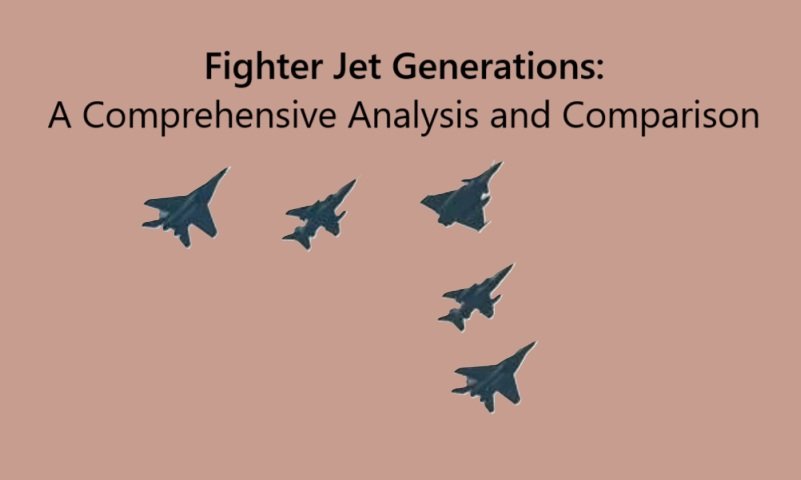
Fighter jets have evolved significantly over the decades, transitioning through different generations as technology advanced. Each generation represents a major leap in aerodynamics, avionics, weapons systems, stealth, and maneuverability. This article provides an in-depth analysis of fighter jet generations, highlighting their capabilities, advancements, and comparisons.
1st Generation (1945-1955): Subsonic Jets
Key Features:
- Introduction of jet propulsion replacing piston engines
- Subsonic speeds (< Mach 1)
- Straight wings and basic aerodynamics
- Manual controls with no electronic assistance
- Early air-to-air guns as primary weapons
Notable Aircraft:
- Messerschmitt Me 262 (Germany) – The world’s first operational jet-powered fighter
- F-86 Sabre (USA) – Dominated aerial combat in the Korean War
- Mikoyan-Gurevich MiG-15 (USSR) – Competitor to the F-86
Comparison:
| Feature | 1st Generation |
|---|---|
| Speed | Subsonic (< Mach 1) |
| Weapons | Guns and early missiles |
| Avionics | Basic radar systems |
| Maneuverability | Moderate |
2nd Generation (1955-1965): Early Supersonic Fighters
Key Features:
- Supersonic capability (> Mach 1)
- Swept or delta wings for better aerodynamics
- Early guided air-to-air missiles
- More advanced radars and avionics
- Introduction of afterburners
Notable Aircraft:
- F-104 Starfighter (USA) – High-speed interceptor
- MiG-21 (USSR) – Mass-produced and widely exported
- English Electric Lightning (UK) – Exceptional climb rate and speed
Comparison:
| Feature | 2nd Generation |
|---|---|
| Speed | Mach 1 – Mach 2 |
| Weapons | Guns + early guided missiles |
| Avionics | Improved radar and targeting |
| Maneuverability | High-speed optimized |
3rd Generation (1965-1980): Multirole Fighters
Key Features:
- Improved maneuverability and aerodynamics
- Enhanced avionics, radar systems, and sensors
- Capability to carry multiple weapon types
- Introduction of pulse-doppler radar for beyond-visual-range (BVR) combat
- Beginning of fly-by-wire control systems
Notable Aircraft:
- F-4 Phantom II (USA) – Highly versatile multirole aircraft
- MiG-23 (USSR) – Variable-sweep wing design
- Dassault Mirage F1 (France) – Advanced radar and avionics for its time
Comparison:
| Feature | 3rd Generation |
|---|---|
| Speed | Mach 1 – Mach 2+ |
| Weapons | Advanced guided missiles, guns |
| Avionics | Doppler radar and ECM systems |
| Maneuverability | Improved with better aerodynamics |
4th Generation (1980-Present): Agile Multirole Fighters
Key Features:
- Exceptional maneuverability (high thrust-to-weight ratio)
- Advanced avionics, fly-by-wire controls, and digital cockpit
- High-speed data links and electronic countermeasures (ECM)
- Increased stealth features (composite materials and reduced RCS)
- Multi-mode radar for enhanced situational awareness
Notable Aircraft:
- F-16 Fighting Falcon (USA) – Highly maneuverable and widely exported
- Su-27 (USSR/Russia) – Superior dogfight capabilities
- Dassault Rafale (France) – Advanced avionics and multirole capability
- Eurofighter Typhoon (Europe) – High agility and advanced radar
Comparison:
| Feature | 4th Generation |
|---|---|
| Speed | Mach 2+ |
| Weapons | BVR missiles, guided bombs |
| Avionics | Multi-mode radar, ECM, fly-by-wire |
| Maneuverability | High, thrust-vectoring in some |
4.5th Generation (1995-Present): Enhanced Capabilities
Key Features:
- AESA (Active Electronically Scanned Array) radar for superior tracking
- Stealth improvements but not full stealth
- Data fusion capabilities
- Advanced networking and electronic warfare systems
Notable Aircraft:
- Su-35 (Russia) – Supermaneuverability with thrust-vectoring
- F/A-18 Super Hornet (USA) – Upgraded avionics and stealth coatings
- JAS-39 Gripen (Sweden) – Lightweight and cost-effective multirole fighter
Comparison:
| Feature | 4.5th Generation |
|---|---|
| Speed | Mach 2+ |
| Weapons | Advanced BVR, smart munitions |
| Avionics | AESA radar, data fusion |
| Maneuverability | Superior with thrust-vectoring |
5th Generation (2005-Present): Stealth Dominance
Key Features:
- Full stealth technology (reduced radar cross-section)
- Supercruise capability (sustained supersonic speed without afterburner)
- Advanced sensor fusion and data integration
- Network-centric warfare capability
- High-end electronic warfare capabilities
Notable Aircraft:
- F-22 Raptor (USA) – Air superiority with unmatched stealth
- F-35 Lightning II (USA) – Multirole with advanced avionics
- Chengdu J-20 (China) – Stealthy long-range fighter
- Sukhoi Su-57 (Russia) – Stealth and high maneuverability
Comparison:
| Feature | 5th Generation |
|---|---|
| Speed | Mach 2+ (supercruise) |
| Weapons | Stealth-compatible missiles, smart bombs |
| Avionics | Sensor fusion, AI-assisted targeting |
| Maneuverability | Extreme, stealth-optimized |
6th Generation (Future Development)
Expected Features:
- AI-powered autonomous operations
- Hypersonic speeds (> Mach 5)
- Directed energy weapons (lasers, electromagnetic pulse weapons)
- Enhanced stealth with active camouflage
- Swarm drone integration
- Advanced human-machine teaming
Upcoming Projects:
- NGAD (Next-Generation Air Dominance) (USA) – Expected 2030s
- FCAS (Future Combat Air System) (Europe) – Planned 2040
- Tempest (UK-led project) – Advanced AI and hypersonic capability
Projected Comparison:
| Feature | 6th Generation |
|---|---|
| Speed | Mach 5+ (hypersonic) |
| Weapons | AI-directed laser and hypersonic missiles |
| Avionics | Quantum computing, AI-assisted dogfighting |
| Maneuverability | Extreme, autonomous control |
Comparison of Fighter Jet Generations
| Generation | Time Period | Key Features | Notable Aircraft | Speed | Avionics & Technology | Weapons & Capabilities |
|---|---|---|---|---|---|---|
| 1st Generation | 1940s – 1950s | Subsonic speeds, straight wings, manual controls, minimal radar | MiG-15, F-86 Sabre, Gloster Meteor | ~1,000 km/h | Basic radar, gunsights | Machine guns, early air-to-air missiles |
| 2nd Generation | 1950s – 1960s | Introduction of supersonic speeds, swept wings, early guided missiles | MiG-19, F-104 Starfighter, English Electric Lightning | 1,200 – 2,000 km/h | Early radar, infrared targeting | Early guided air-to-air missiles, improved cannons |
| 3rd Generation | 1960s – 1970s | Advanced avionics, improved radar, enhanced maneuverability | MiG-21, F-4 Phantom II, Mirage III | 2,000+ km/h | Pulse-Doppler radar, ECM systems | Beyond-visual-range (BVR) missiles, multi-role capability |
| 4th Generation | 1970s – 1990s | Fly-by-wire controls, high maneuverability, advanced avionics | F-16, MiG-29, Su-27, Mirage 2000 | Mach 2+ | Multi-mode radar, composite materials, improved ECM | Advanced air-to-air & air-to-ground missiles, precision-guided munitions |
| 4.5 Generation | 1990s – 2000s | Stealth features, AESA radar, thrust vectoring | Rafale, Eurofighter Typhoon, Su-35, F/A-18E/F Super Hornet | Mach 2+ | AESA radar, sensor fusion, enhanced ECM | Highly advanced guided munitions, network-centric warfare |
| 5th Generation | 2000s – Present | Full stealth, sensor fusion, supercruise, AI integration | F-22 Raptor, F-35 Lightning II, Su-57, J-20 | Mach 2+ (with supercruise capability) | AESA radar, AI-assisted combat, data-link integration | Stealthy munitions, advanced electronic warfare (EW) capabilities |
| 6th Generation | 2030s+ (Upcoming) | Full AI autonomy, drone integration, hypersonic capabilities, directed-energy weapons | NGAD (USA), Tempest (UK), FCAS (EU) | Hypersonic (Mach 5+) | AI-powered combat assistance, cloud-based warfare | Hypersonic missiles, laser-based weapons, drone swarms |
Conclusion
Fighter jets have seen incredible advancements through generations, from early subsonic jets to highly sophisticated stealth fighters. As we move into the future, next-generation technologies will redefine air combat with AI, hypersonics, and energy weapons. The development of these aircraft continues to push the boundaries of aerospace engineering, shaping the future of aerial warfare and defense strategies worldwide.
The evolution of fighter jets is a testament to human ingenuity, and the next few decades promise even greater breakthroughs in speed, stealth, and warfare capabilities.





